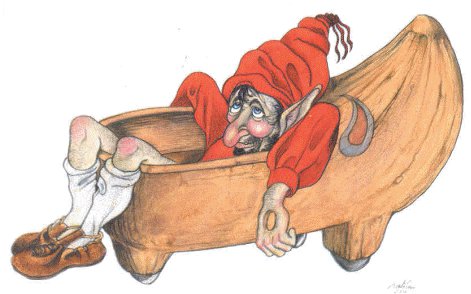Spanish mythological creatures: el trasgo Posted by Magda on Dec 14, 2010 in Spanish Culture
Mythological creatures were a deep-rooted belief in Spanish popular culture well into the 18th century. The Catholic Church had to fight against these myths, even recruiting the Inquisition as an instrument to control them, since some of these creatures were considered minor demons, and a danger to Christian faith. Today we will talk about one of these creatures, specifically the Trasgo (or Trasgu, as it is known in Asturias).
Trasgos are tiny beings similar to goblins or gnomes. They are usually friendly and hard-working, the wear a red shirt and a cap of the same color. It is a home goblin, entering the house when the fireplace is burning, and they like to stay close to it. They also frequent other parts of the house, like the attic and the stables. Their physical description varies according to the region, but there are some common features. Sometimes they are represented with horns and a tail, they usually have a limp, although their legs are long and thin. Their hands y fingers are also long, but Trasgos have a hole in the middle of their left hand.
Normally, when Trasgos are in good spirits and they are treated well, they take it upon themselves to do house chores, so they work putting everything in its place, cleaning the house, sweeping, and helping the family. However, if you wrong them or they are in a bad mood, they will break the dishes, hide objects, mess up the clothes, and scream and shout to scare the animals away. If a trasgo turns out to be excessively mischievous or annoying, the house owners have to come up with a trick to get rid of him. In order to do that, they have to use his self-esteem. Trasgos fancy themselves as being very organized, and keeping everything clean and tidy. For that reason, the family can charge him with any of these three tasks:
-they spread linseed or millet on the floor and ask him to pick it up. The Trasgo will not be able to, since the fall through the hole in his hand.
-they may also order him to whiten the skin of a black ram, which is impossible.
-the third option is to ask him to fetch water in a basket.
When the Trasgo realizes that he cannot complete the task, he feels hurt in his pride, and leaves the house never to return again.
The figure of the Trasgo is a part of popular culture even today. In some villages there are still families who believe that these goblins live in their houses. It is not only part of Spanish folklore, but also other European countries where similar creatures exist, under names such as kobold, lutin, nix, or puck. If you ever see one living at home with you, make sure you treat him well!
Hasta bien entrado el siglo XVIII, en España se consideraba perfectamente creíble la existencia de seres mitológicos en la cultura popular. La Iglesia tuvo que luchar contra estas creencias, llegando incluso a utilizar a la Inquisición como método de control, ya que algunas de estas criaturas se consideraban demonios menores y peligrosos contra la fe cristiana. Hoy vamos a hablar de una de esas criaturas, concretamente el Trasgo (o Trasgu, como se le conoce en Asturias).
El Trasgu es similar a un duende o gnomo de figura diminuta. Normalemente es simpático y laborioso, viste una camisa roja y gorro del mismo color. Es un duende casero, que penetra en las casas cuando el fuego está encendido, y suele permanecer cerca de él. También frecuenta otros lugares de la casa, como el desván, y las cuadras o corrales. Su descripción física varía según la zona, pero tiene rasgos comunes. A veces aparece dibujado con cuernos y rabo, normalmente es cojo, aunque sus piernas son largas y delgadas. Sus manos y dedos también son largos, pero el Trasgo tiene un agujero en el centro de la mano izquierda.
Normalmente, cuando el Trasgo está de buen humor y lo tratan bien, se preocupa de hacer las labores domésticas y trabaja colocando todo en su sitio, limpiando la casa, barriendo y ayudando a la familia. Sin embargo, si se le enfada o está de mal humor, rompe los cacharros, esconde objetos, revuelve la ropa y da voces y gritos espantando al ganado. Si un trasgo se vuelve demasiado travieso o molesto, los dueños de la casa tienen que inventarse un truco para deshacerse de él. Para eso utilizan su amor propio. Los trasgos presumen de ser muy organizados y de tenerlo todo muy ordenado y limpio. Por ese motivo, la familia puede mandarle a hacer cualquiera de estas tres tareas:
-echan linaza o mijo por el suelo y se lo mandan recojer. El Trasgo no podrá hacerlo porque se escapan por el agujero de su mano.
-también pueden mandarle blanquear la piel de un carnero negro, que es una tarea imposible.
-la tercera opción es mandarle traer un cesto lleno de agua.
Cuando el Trasgo ve que no consigue realizar la tarea, se siente herido en su amor propio y abandona la casa para no volver jamás.
La figura del Trasgo es parte de la cultura popular incluso en el día de hoy. En algunos pueblos todavía hay familias que creen que estos duendes viven en sus casas. Tampoco es solamente típico de la cultura española, ya que hay criaturas similares en otros países europeos, con nombres como kobold, lutin, nix, o puck. Si alguna vez ven uno en su casa, ¡asegúrense de tratarlo bien!

Build vocabulary, practice pronunciation, and more with Transparent Language Online. Available anytime, anywhere, on any device.




